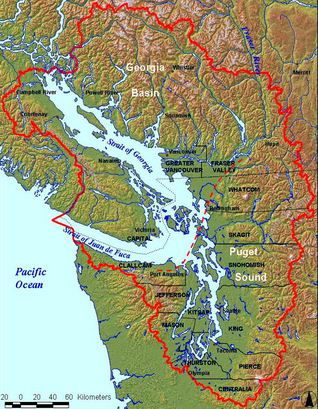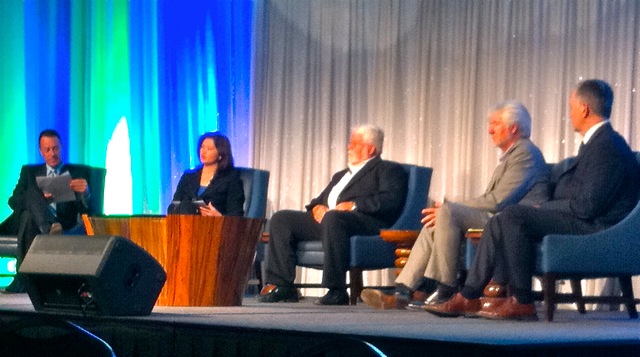REPORT FROM STORMCON 2011: "Changing the Rules: How Will New Stormwater Regulations Affect Municipal Programs in the United States"
Note to Reader:
In August 2011, the 10th Annual North American Storwater Surface Quality Conference and Exposition (StormCon) was held in Anaheim, California. Described as the leading educational forum for stormwater professionals, StormCon opened with a plenary panel discussion on recent trends and changes in the way rainwater/stormwater is managed. The panel offered their insights on what they believe will develop in the next few years.
The 5-person panel comprised four experienced American consultants and the president of one of the largest equipment suppliers in the United States. To learn more about their credentials, click on StormCon2011 Plenary Panel.
In the first part of the article below, Thomas Low highlights what the panelists said. He is author of the Light Imprint Handbook: Integrating Sustainability and Community Design. “The term Light Imprint basically means ‘laying lightly on the land.’ And that’s where the name came from, it’s just thinking that way. Respecting the natural drainage and topography in a way that actually makes more sense,” explains Thomas Low.
The second part of the article reflect on the goals driving changes in drainage practice in both the United States and British Columbia. While land use and infrastructure professionals are using a similar vocabulary on both sides of the border, the goals are different.
Move to ‘More Benign Planning’ (MBP)
“The overall buzz of the conference was that the stormwater industry is changing. And as one of the panelists stated, this change needs to move towards MBP, that is, ‘more benign planning’ ….instead of more BMPs or ‘best management practices’,” reports Thomas Low in capturing a defining sound-bite from the conference. 
“Along with the ‘More Benign Planning’ emphasis, I also keep hearing over and over again about the need for education. This is one of the main reasons we decided to engage participants in the Light Imprint Workshop at StormCon 2011 with a hands-on session using our ‘Mixopoly’ game format.”
To Learn More: Click on Light Imprint: Integrating Sustainable Green Infrastructure and Community Design to download the agenda for the workshop.
Nine Questions
At the plenary session, the StormCon 2011 panel considered these nine questions:
- What should be included in the new EPA standards coming out in September?
- What BMPs should be emphasized?
- How do you determine the efffectiveness of a Treatment Train approach?
- What is Passé versus Avant Garde?
- Where does ‘maintenance’ fit into the overall passé or avant gard plan?
- Are we over-regulated – what is the ideal permit?
- At what in time do we believe the numeric limits are absolute and cannot be exceeded?
- Are we on the wrong path?
- Where is the designer in all this?
Of the nine questions, #4 is the most intriguing and resulted in the most insightful observations about trends and what to expect. Question #6 yielded the second most interesting response.
Passé versus Avant Garde?
“The panel reminded us that the stormwater profession is a silo, and so we need to reach out to urban planners, transportation planners, etc.,” states Thomas Low. He also quoted panelist Paul Crabtree who identified three categories of passé vs avant garde.
 “First, business as usual is passé. There’s a Triple Crisis of climate change, energy cost escalation, and financial meltdowns. We are looking at a reset, not a recovery. The New Leaner Economy is the avant garde,” observed Paul Crabtree, leader of the CNU Rainwater Initiative. To learn more, click here.
“First, business as usual is passé. There’s a Triple Crisis of climate change, energy cost escalation, and financial meltdowns. We are looking at a reset, not a recovery. The New Leaner Economy is the avant garde,” observed Paul Crabtree, leader of the CNU Rainwater Initiative. To learn more, click here.- “Secondly, the notion of cities being a problem is passé. Actually, ‘cities are the solution’is the avant garde message.”
- “Thirdly, the term of LID or low impact development is passé. The new term of choice will be Green Infrastructure. In this country, the stormwater industry first did a great job of reclamation (filling of swamps and building of dams), the next big thing was flood control (building concrete channels and detention ponds), and now the fixation is on holding all water where it lands. Green Infrastructure will use a broad range of tools, each in the right context,” emphasized Paul Crabtree.
In summarizing the panel discussion around Question #4, Thomas Low reports that: “The panelists agreed that it is also passé to allocate so much time to administrative work. given that the End Goal is to improve water quality. Avant guarde is a key solution. All the time spent on water quality monitoring is a fool’s erand. Avant guarde is about pooling our resources.”
Are We Over Regulated?
Panelist Paul Crabtree compared stormwater regulations to War and Peace because of their length; to reinforce the analogy, he quoted Abraham Lincoln as follows: “I am sorry I did not have time to write a shorter letter.”
“With the New Economy combined with layering on regulations, we should consider that most builders are not even getting to the permit counter,” commented Paul Crabtree. “The builders that made it through all the rules to get to construction are the exception, not the rule. That is a bigger problem than trying to enforce regulations on those that are actually building. If you make it too hard to make it through the approvals then the person that may be willing to do the right project – that is. a redevelopment site will never make it to implement the right project.”
The View from British Columbia
 “From our vantage point in British Columbia, our observation is that American practitioners are addressing the problem that their legislation is directing them toward. Everyone down there is trying to comply with prescriptive rules flowing from their Clean Water Act. As Thomas Low highlights in his report from StormCon 2011, their End Goal is to improve water quality,” comments Kim Stephens, Executive Director of the Partnership for Water Sustainability in British Columbia.
“From our vantage point in British Columbia, our observation is that American practitioners are addressing the problem that their legislation is directing them toward. Everyone down there is trying to comply with prescriptive rules flowing from their Clean Water Act. As Thomas Low highlights in his report from StormCon 2011, their End Goal is to improve water quality,” comments Kim Stephens, Executive Director of the Partnership for Water Sustainability in British Columbia.
What is the Goal, Really?
“There is nothing in the Clean Water Act about stream health, at least in terms of how we define stream health in British Columbia. The Clean Water Act is all about discharge water quality and the loadings that are in the water. Infiltration systems are now seen as a way to eliminate the discharge and hence the problem. In short, the Americans have a different driver than we have in British Columbia.”
“The approach we have taken in British Columbia differs from that of the United States Environmental Protection Agency (EPA) due to the nature of the root problems being solved. A critical issue in Pacific Northwest bio-region is the damage and loss of habitat caused by development and erosion of the headwater streams. Going back to the salmon crisis in the1990s, the genesis for our focus on the stream health benefits of Green Infrastructure was a response to Canada’s Fisheries Act. It prohibits damage of fish habitat.”
“In the 1990s, the pioneering work of Richard Horner and Chris May at the University of Washington shook conventional stormwater management wisdom in the Pacific Northwest to its foundation. Their work is a foundation block for the science-based approach to ‘designing with nature’ that we have embraced. Horner and May identified and ranked the four factors that limit stream health. Changes in hydrology is #1; deterioration in water quality is #4. If the goal is protection of aquatic resources, Horner and May showed that a water quality driven program would not achieve the goal.”
“In the United States, the EPA has focussed upon water quality in the main stems and coastal waters and seeks to restore the resources of those waters through the goals and objectives of the Clean Water Act.”
Can the USA Learn from British Columbia Experience?
“One gets the impression that the efforts of both the EPA and British Columbia may be moving closer, and perhaps over time we may achieve alignment. The National Lakes Assessment, for example, is the first-ever comprehensive assessment of lakes in the United States. This study found that habitat loss and nitrogen and phosphorus pollution are leading causes of impairment. This is among the first EPA documents that acknowledges habitat loss ahead of excess nutrient loadings as being a factor in environmental health.”
“Similarly, the objectives of A Strategic Agenda to Protect Waters and Build More Livable Communities Through Green Infrastructure could lead the United States to pay closer attention to the pioneering work of Horner and May and others. Perhaps when the EPA focus shifts from water quality to include habitat loss, the lessons learned in British Columbia can be reviewed and incorporated into the policies and objectives of the EPA?”
“In British Columbia, our focus has been on stream habitat. Looking well down the road, our emphasis may some day shift to include water quality, but that would likely be once the efforts to mitigate habitat damage become universal and effective practice. This could lead to the next evolution in creating a greener and more sustainable environment for each unique watershed,” concludes Kim Stephens.
To Learn More:
To access supporting information on the approach that has been implemented in British Columbia, click on:
- DFO Urban Stormwater Guidelines have evolved into ‘Beyond the Guidebook 2010’
- A Science-Based Road Map for Integrated Rainwater Management
- “Understand How Water Reaches the Stream and Design for Interflow”, urges Department of Fisheries and Oceans
Also, for a philosophical perspective, click on Do you know where you really are in the shifting paradigms of stormwater management?

Posted August 2011



